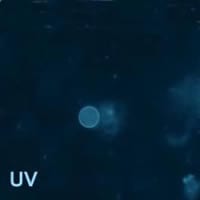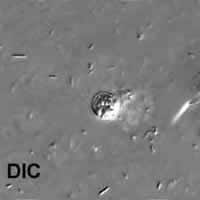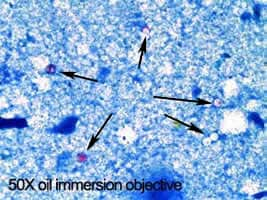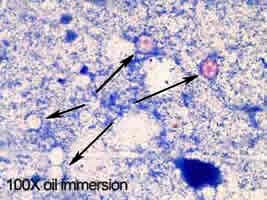
Monthy Case Studies - 2001
Case #53 - February, 2001
A state public health laboratory submitted a formalin preserved stool specimen to CDC reference laboratory for diagnosis. The specimen was from a middle-aged woman who had abdominal pain and diarrhea. Her symptoms began approximately one week after she attended a social function where she ate only dessert and drank fruit punch. She prepared all the food she ate between the social function and onset of symptoms. Her stool specimen was processed using the FEA stool concentration method and a wet-mount slide prepared from the sediment. Figures A and B show a side-by-side composite of objects seen in her stool using UV fluorescence and differential interference contrast (DIC) microscopy. All objects were approximately nine micrometers in diameter. What is your diagnosis? Based on what criteria? What other test(s) would you recommend?

Figure A

Figure B
Answer to Case #53
This was a case of cyclosporiasis caused by Cyclospora cayetanensis. The images in this case show the usefulness of alternative methods for diagnosing this coccidian parasite. Diagnostic features observed were:
- autofluorescent oocysts under ultraviolet light (Figure A).
- nonrefractile oocysts were within the size range of C. cayetanensis (eight to ten µm).
The modified acid-fast stain is the most common method used for the detection of C. cayetanensis; it also provides a permanent record. However, because C. cayetanensis stains variably, as shown in Figures C and D, some oocysts may stain dark red or pink, while others may not stain at all. Misdiagnosis occurs when oocysts are confused with artifacts or go undetected in a dense background.

Figure C

Figure D
The two methods shown in this case, UV fluorescence and DIC microscopy, do not require staining of the specimen and can allow a definitive diagnosis. However, these methods do not generate a permanent record.
Because C. cayetanensis has been associated with recent outbreaks in the United States, health care officials should be alerted to increased frequency of reports. This case was based on an outbreak in which a dessert made with fresh raspberries was implicated as the vehicle for the outbreak. Nearly 50 people were affected with an attack rate of approximately 60%.
More on: Cyclosporiasis
Images presented in the monthly case studies are from specimens submitted for diagnosis or archiving. On rare occasions, clinical histories given may be partly fictitious.
 ShareCompartir
ShareCompartir


